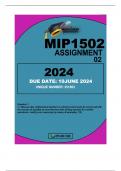,MIP1502 ASSIGNMENT 02
UNIQUE NUMBER: 351863
DUE DATE: 10 JUNE 2024
Question 1
1.1 Discuss why mathematics teachers in primary school must be concerned with
the concept of equality as soon learners start writing symbols for number
operations. Justify your reasoning by means of examples. (12)
Mathematics teachers in primary school must be deeply concerned with the concept of equality
from the moment learners begin writing symbols for number operations. This foundational concept
forms the basis of mathematical understanding and problem-solving skills that students will utilize
throughout their academic and practical lives. Below are several reasons why equality is crucial in
primary mathematics education, along with examples to illustrate these points:
1.Foundation for Basic Arithmetic Operations: Understanding equality is fundamental for performing
basic arithmetic operations such as addition, subtraction, multiplication, and division. For example,
in the equation 3+4=7, the concept of equality signifies that the two sides of the equation are
balanced, indicating that 3+4 results in the same value as 7.
2.Equivalence and Balance: Equality introduces the notion of equivalence and balance, teaching
students that mathematical expressions or equations can have the same value on both sides. For
instance, in the equation 5+2=3+4, learners learn that 5+2 is equal to 3+4, demonstrating the
concept of balance.
3.Comparison and Relational Understanding: Equality enables learners to compare quantities and
develop relational understanding. For example, in the inequality 8>5, learners recognize that 8 is
greater than 5, demonstrating an understanding of comparative relationships.
Problem-solving Skills: Understanding equality is essential for solving mathematical problems and
equations. For instance, in the equation 2x+3=7, learners must apply the concept of equality to find
the value of x that satisfies the equation.
Algebraic Thinking: Equality serves as a bridge to algebraic thinking, where learners manipulate
symbols and equations to solve problems. For example, in the equation 2x=10, learners apply the
concept of equality to isolate the variable 𝑥 and determine its value.
Real-world Applications: Equality extends beyond abstract mathematical concepts and finds
application in real-world scenarios, such as sharing equally among friends, dividing resources, or
solving everyday problems involving quantities.
In conclusion, the concept of equality is fundamental in primary mathematics education as it forms
the basis for basic arithmetic operations, introduces the notion of equivalence and balance, fosters
relational understanding, develops problem-solving skills, facilitates algebraic thinking, and finds
application in real-world contexts. Mathematics teachers must ensure that learners grasp this
concept from the outset, as it lays the groundwork for future mathematical proficiency and critical
thinking skills.
Reference:
, National Council of Teachers of Mathematics (NCTM). (2000). Principles and Standards for School
Mathematics. Reston, VA: Author.
Question 2
2.1 Express each of the following problems using an equation with one variable.
2.1.1 Nomasizwe has R70.50 and wants to buy a movie ticket, which costs
R120.00. How much more does she need? (2)
To express the problem using an equation with one variable, let's represent the amount Nomasizwe
needs as x .
Given:
- Nomasizwe has R70.50
- The movie ticket costs R120.00
We can set up the equation:
70.50 + x = 120.00
Here, x represents the additional amount Nomasizwe needs to buy the movie ticket. We add x to the
amount she already has, and the total should equal the cost of the movie ticket.
So, to find out how much more Nomasizwe needs, we need to solve for x in the equation 70.50 + x
= 120.00 .
2.1.2 Leekay has 8 animal toys and received 3 more. How many does she have
now? (2)
Let's represent the number of animal toys Leekay has as 𝑥
Given:
Leekay has 8 animal toys
She received 3 more
We can set up the equation:
𝑥+3=total number of animal toys
Here, 𝑥 represents the initial number of animal toys Leekay had, and adding 3 to that should equal
the total number of animal toys she has now.
So, to find out how many animal toys Leekay has now, we need to solve for 𝑥+3.
2.1.3 Darlene is a teacher. She bought 10 boxes of coloured markers for her
learners. Each box has 12 markers. She packages them into bags for
each of her 30 learners. If each learner gets the same number of markers,
how many markers are in each bag? (4)




